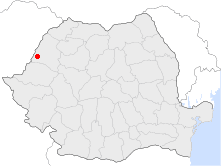Salonta
|
Salonta Nagyszalonta |
||
|---|---|---|
| Municipality | ||

Peasant Museum
|
||
|
||
 Location of Salonta |
||
| Coordinates: 46°48′0″N 21°39′0″E / 46.80000°N 21.65000°ECoordinates: 46°48′0″N 21°39′0″E / 46.80000°N 21.65000°E | ||
| Country |
|
|
| County | Bihor County | |
| Status | Municipality | |
| Government | ||
| • Mayor | László Török (UDMR) | |
| Population (2002) | ||
| • Total | 18,074 | |
| Time zone | EET (UTC+2) | |
| • Summer (DST) | EEST (UTC+3) | |
| Climate | Cfb | |
| Website | http://www.salonta.net/en/fooldal.htm | |
Salonta (Romanian pronunciation: [saˈlonta]; Hungarian: Nagyszalonta, German: Grosssalontha; Turkish: Salanta) is a city in Bihor County, in the geographical region of Crișana, north-western Romania, near the Hungarian border.
According to the Romanian census from 2011, the city has a population of 17,042, made up of Hungarians (58.1%), Romanians (38.83%), Romani (2.4%), Slovaks 0.4% and others (0.5%). In terms of religion, in year 2002, 51.12% were Reformed (Calvinist), 36.46% Romanian Orthodox, 6.56% Roman Catholic and 5.86% was split between Baptists, Romanian Greek-Catholic, Pentecostals and other faiths.
The city, a part of the Kingdom of Hungary, was first documented in 1214 under the name of Zolonta and in 1332 a Papal document used the name Zalanta. From 1587 the Hungarian spelling Szalonta was used.
Until the 16th century, it was only a small village of about 300 inhabitants and was on the land of the Toldi family. A bigger city was the fort of Culiser, which was however destroyed by the Turks in 1598.
Culiser was never rebuilt and Salonta began to have a more important role in the region after 1606, when the prince of Transylvania, Stephan Bocskai settled 300 soldiers here and appropriated land for them. They built their own farms, but had to keep their arms ready to repel an attack by the Turks. 3 June, the day in which the soldiers were settled, is nowadays declared "the day of the city". However, Ottoman Turks captured the town in 1660 and as "Salanta", it became the sanjak center of Varat vilayet until 1692.
...
Wikipedia

